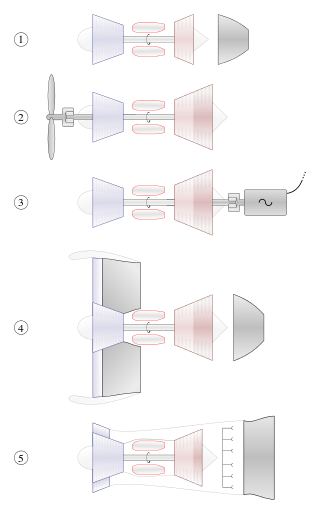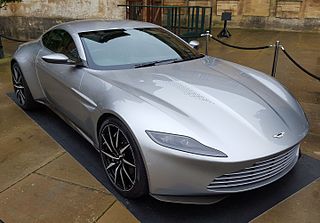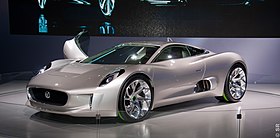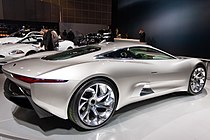
A gas turbine,gas turbine engine, or also known by its old name internal combustion turbine, is a type of continuous flow internal combustion engine. The main parts common to all gas turbine engines form the power-producing part and are, in the direction of flow:

Lotus Group is a British multinational automotive manufacturer of luxury sports cars and electric lifestyle vehicles.

The Jaguar E-Type, or the Jaguar XK-E for the North American market, is a British front mid-engined sports car that was manufactured by Jaguar Cars Ltd from 1961 to 1974. Its combination of exceptional aesthetics, advanced technologies, high performance, and competitive pricing established the model as an icon of the motoring world. The E-Type's claimed 150 miles per hour (240 km/h) top speed, sub-7-second 0 to 60 mph (97 km/h) acceleration, largely unitary body construction, front and rear independent suspension with disc brakes, mounted inboard at the rear, and rack-and-pinion steering, distinguished the car and spurred industry-wide changes.

The Aston Martin Vanquish is a grand tourer introduced by British luxury automobile manufacturer Aston Martin in 2001 as a successor to the Aston Martin Vantage (1993).

A compressed-air vehicle (CAV) is a transport mechanism fueled by tanks of pressurized atmospheric gas and propelled by the release and expansion of the gas within a pneumatic motor.

The Volkswagen XL1 is a two-person limited production diesel-powered plug-in hybrid produced by Volkswagen. The XL1 car was designed to be able to travel 100 km on 1 litre of diesel, while being both roadworthy and practical. To achieve such economy, it was produced with lightweight materials, a streamlined body and an engine and transmission designed and tuned for economy. The concept car was modified first in 2009 as the L1 and again in 2011 as the XL1.
A microturbine (MT) is a small gas turbine with similar cycles and components to a heavy gas turbine. The MT power-to-weight ratio is better than a heavy gas turbine because the reduction of turbine diameters causes an increase in shaft rotational speed. Heavy gas turbine generators are too large and too expensive for distributed power applications, so MTs are developed for small-scale power like electrical power generation alone or as combined cooling, heating, and power (CCHP) systems. The MT are 25 to 500 kW (34 to 671 hp) gas turbines evolved from piston engine turbochargers, aircraft auxiliary power units (APU) or small jet engines, the size of a refrigerator. Early turbines of 30–70 kW (40–94 hp) grew to 200–250 kW (270–340 hp).

The Turbotrain was any of several French high-speed, gas turbine trains. The earliest Turbotrain entered service in 1967, for use on France's SNCF intercity lines. There were four versions in total, with the last exiting service in 2005, and it is the Turbotrain that made advances possible for the TGV.

A gas turbine locomotive is a type of railway locomotive in which the prime mover is a gas turbine. Several types of gas turbine locomotive have been developed, differing mainly in the means by which mechanical power is conveyed to the driving wheels (drivers). A gas turbine train typically consists of two power cars, and one or more intermediate passenger cars.
The Spectre R42 is a 2-seater mid-engined rear-wheel drive sports car manufactured by British boutique automobile manufacturer Spectre Supersports Ltd.

The Jaguar F-Type (X152) is a series of two-door, two-seater grand tourers manufactured by British car manufacturer Jaguar Land Rover under their Jaguar Cars marque since 2013. The car's JLR D6a platform is based on a shortened version of the XK's platform. It is the so-called "spiritual successor" to the famous E-Type.

The Porsche 918 Spyder is a sports car manufactured by German marque Porsche. The 918 Spyder is a plug-in hybrid powered by a mid-mounted naturally aspirated 4.6 L (4,593 cc) V8 engine, developing 447 kW at 8,700 RPM, with two electric motors delivering an additional 210 kW for a combined output of 652 kW (875 hp) and 1,280 N⋅m (944 lbf⋅ft) of torque. The 918 Spyder's 6.8 kWh lithium-ion battery pack delivers an all-electric range of 19 km (12 mi) under the US Environmental Protection Agency's five-cycle tests.

The Jaguar C-X16 is a concept hybrid electric sports car that was unveiled by Jaguar Cars at the 2011 Frankfurt Motor Show on 13 September. In April 2012, Jaguar announced that they will be manufacturing a new sports car based on the Jaguar C-X16 called the F-Type, which was subsequently shown to the public at the Paris Motor Show in September 2012.

The McLaren P1 is a sports car produced by British marque McLaren Automotive. It is a plug-in hybrid with a mid-engine layout. It was first shown at the 2012 Paris Motor Show, with sales of the P1 beginning in the United Kingdom in October 2013 and all of the limited run of 375 units sold by November 2013. Production ended in early December 2015. The United States accounted for 34% of the units and Europe for 26%.

The Aston Martin DB10 is a bespoke grand tourer specially developed for the James Bond filmSpectre by the British luxury car manufacturer Aston Martin.
YASA is a British manufacturer of electric motors and motor controllers for use in automotive and industrial applications. The company was founded in 2009 by the CTO Dr Tim Woolmer who is also the holder of a number of related motor technology patents. Although initial commercial adoption was in high-performance cars, markets for YASA e-motors and generators now include the off-road, marine, industrial and aerospace sectors.

The Techrules Ren is a single-door, high-performance sports car manufactured by Techrules, and designed by Fabrizio Giugiaro and Giorgetto Giugiaro of GFG Style. At its launch, it will become the first sports car to contain a turbine engine. This is also the first production sports car from Techrules. Expectations for the vehicle's construction are 10 (hand-built) per year.
The electric Jaguar XJ was a battery-electric luxury saloon car due to be launched in 2021 by British car company Jaguar Land Rover (JLR) under their Jaguar Cars marque. It was to supersede the XJ (X351), the last example of which was built in July 2019. In February 2021, CEO Thierry Bolloré announced that this car was cancelled as part of Jaguar's Reimagine plan, although the XJ name may be revived at a later date.
Techrules is a Chinese automobile manufacturer headquartered in Yizhuang, China that specializes in producing sports cars.



















